Introduction
Honey bee swarms are a normal sign of a productive and strong honey bee colony. Swarms are colony-level reproduction, which differs from individual bee reproduction (i.e. when more bees are produced within a colony). When a colony swarms, the colony splits into two colonies. As a result, the population of honey bees in the environment grows and genes are exchanged as the new queen in the parent colony mates with drones from other colonies in the surrounding environment. Unfortunately, this activity often conflicts with the goals of the beekeeper. Hive population temporarily decreases in the parent colony, which can adversely impact honey production. Brood rearing is interrupted while the new queen matures, mates, and begins to lay eggs. The swarm that leaves the colony with the old queen can become a nuisance if they cluster on neighboring properties (Figure 1). For the beekeeper, losing a large portion of bees can be undesirable, and neighbors may not appreciate a new swarm of bees on their property.
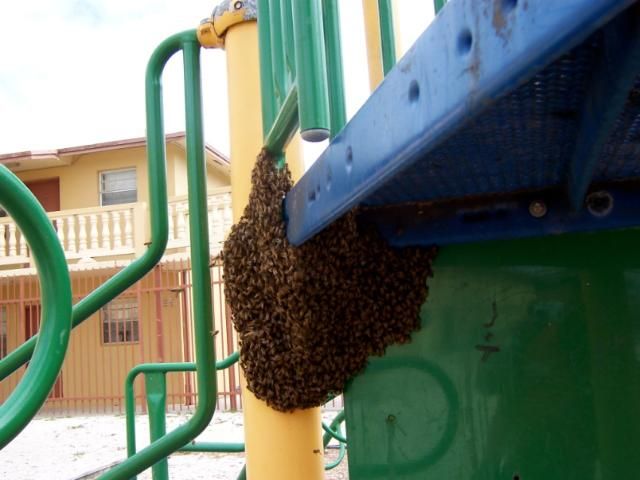
Credit: Willie the Bee Man, Williethebeeman.com
Good colony management includes swarm prevention. Proactive beekeeping practices to alter colonies in response to potential swarming behavior must be undertaken regularly during the swarm season. Good management maintains strong colonies and allows for greater honey production and the potential to split and increase the total number of the beekeeper's colonies, all of which makes beekeeping much more profitable for hive owners.
Swarm Biology
Honey bee colonies, especially colonies of European subspecies of honey bees, tend to swarm in early spring just before and during the principle nectar flow. This is logical since the departing swarm will need significant nutritional resources to build new comb, stock cells with nectar and pollen, and consume enough food for energy to raise new brood. Therefore, beekeepers need to start monitoring for signs of swarming activity in early spring, typically about 2–4 weeks before the main nectar flow begins.
Multiple stimuli likely cause bees to initiate the swarming process. These stimuli include but are not limited to colony congestion (the population is growing with no room to expand in the nest), dilution of queen pheromones, increased availability of nectar and pollen, lengthening daylight, and queen age. While it is true that colonies tend to swarm when they are large, there is evidence to suggest that the number of bees in relation to the size of the hive determines swarming. Thus it is not necessarily that strong colonies swarm but rather that crowded ones do. The smallest of hives will be prompted to swarm if the colony's population exceeds the available space. It has been shown that, under the right conditions, a colony can and will swarm during fall due to overcrowding in the hive, though this is an uncommon occurrence.
When a colony becomes overcrowded, it may be more difficult for workers to detect queen mandibular pheromone, a pheromone known to stabilize the colony. This pheromone elicits and inhibits numerous behaviors in the hive. For example, it prevents workers from developing ovaries and laying eggs. A corresponding lack of this pheromone signals the workers to begin rearing new queens. Thus, swarm preparations may begin in the absence or the dilution of this pheromone in a congested colony.
A lack of open cells in which the queen can lay also may stimulate a colony to swarm. As the hive population begins to grow and adequate space for brood rearing becomes scarce, the queen will lay fertilized eggs in specially constructed, elongated cells called queen cups (Figure 2). These cells are vertically oriented and typically located on the periphery of the comb or frame. While it is common to see queen cups at the bottom of a frame during normal swarm preparations, it is important to know a queen can be reared anywhere on the frame. The female larvae in queen cups are fed a type of brood food known as royal jelly and the cells are capped by worker bees after approximately eight days (Figure 3). The capping of queen cells signals to the hive that it is time to swarm.
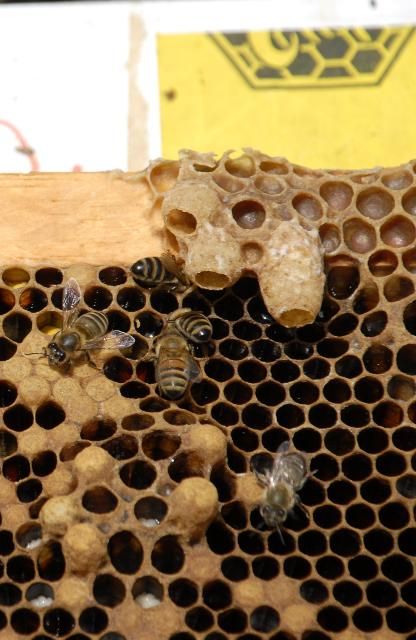
Credit: Mark Dykes, University of Florida
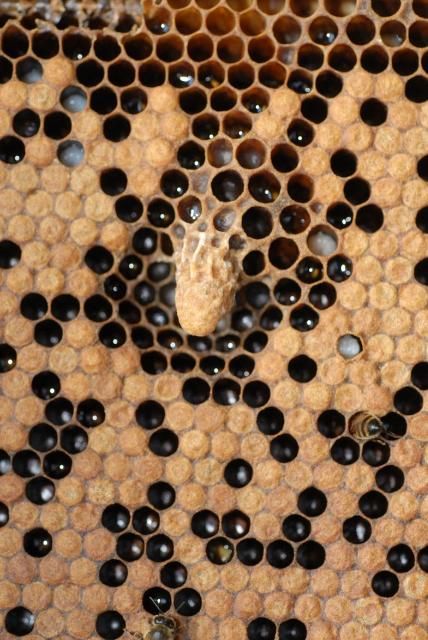
Credit: Mark Dykes, University of Florida
The colony undergoes a number of changes in preparation for swarming. The queen loses a great deal of body weight (worker bees lower the amount of food they provide to the queen—i.e. they put her on a diet), which will aid in her ability to fly to a new hive site. Furthermore, the queen's egg-laying output decreases significantly. Worker bees in the colony begin to crowd the nest, gorging themselves on honey. Other normal activity, such as foraging, will cease temporarily. An audible pitch begins to develop among the workers and a hive about to swarm is significantly louder than one that is not about to swarm.
During the swarm, about 50%–70% of the worker bees rush out of the hive (though this percentage varies), herding the old queen out as they go. The old queen takes flight, lands on a nearby structure (tree branch, fence post, etc.), and the worker bees circling around her land on her, forming a cluster typically ranging in size from a softball to considerably larger than a basketball. The cluster remains at this location, sending scout bees out to find a suitable cavity in which to build a nest. Once such a cavity is found (a process that can take minutes or up to 4 days), the entire cluster flies to the site in one circling mass. The original, "parent" hive is left with about 30–50% of the original bee population, all of the brood, and multiple queens developing in their respective cells. Occasionally, the first virgin queen to emerge will also be a part of a swarm. Such swarms are called secondary swarms, with subsequent swarms being called tertiary and so on. See Box 2 for information on what to do if you find a honey bee swarm.
Recognizing Queen Cups and Cells
Queen cups are common in the hive and are not in themselves a sign that swarming is eminent. A queen cup becomes a queen cell when an egg is laid in the cup and worker bees begin to extend the size of the cell. Normal swarm preparations likely have begun if, in a queenright colony, numerous queen cells are constructed along the outer edges of the frame and have larvae in them that are being fed actively (Figure 4). Once the cells are capped, it is difficult to stop the instinctual swarming behavior.
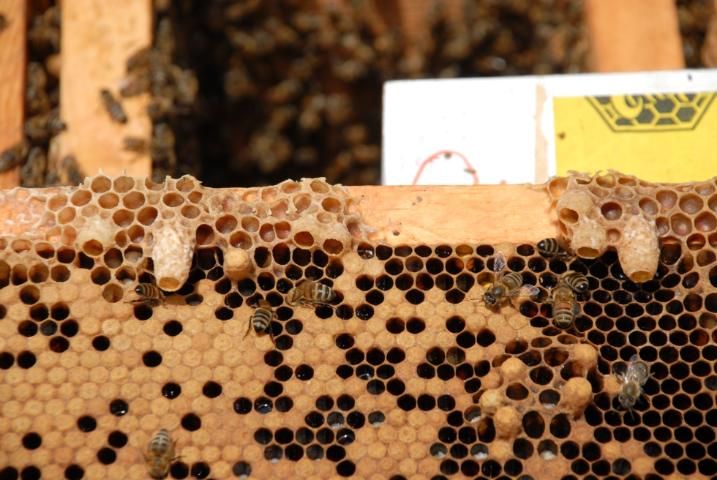
Credit: Mark Dykes, University of Florida
Queen cells can be produced for reasons other than swarming. For example, workers construct supersedure cells when the queen dies, when her pheromone output decreases, or if she begins to fail. In these instances, worker bees will try to rear a queen from young larvae that are already developing into workers. If worker bees change the path of a young worker larva to that of a queen at a young enough age, the resulting queen will develop normally. If, however, the workers try to make a queen from an older worker larva, the resulting queen likely will be inferior. Because of this, workers typically make supersedure cells at the perimeter of the brood pattern, because this is where the youngest worker larvae typically reside (Figure 5). As with everything in nature, there are always exceptions and you may find supersedure cells along the edge of the frame (or normal queen cells within the brood pattern).
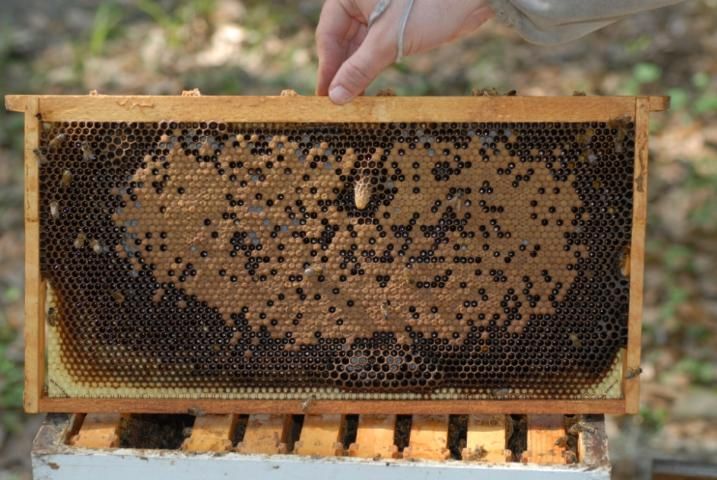
Credit: Mark Dykes, University of Florida
The Parent Colony
The colony left behind, from which the swarm issued, is called the parent colony. Sometimes several queen cells are capped and left to develop, in which case the queens are in a biological race to emerge first. The first queen to emerge may bite through the other neighboring queen cells, prompting workers in the nest to kill the developing queens and remove them from the nest. This does not always occur, and multiple queens emerging in succession may result in several swarms issuing from the parent colony. Eventually one of the newly hatched virgin queens will stay in the old colony and become the new queen. This virgin queen begins her orientation flights a few days after emerging, and later flies out to a drone congregation area where she will mate with multiple drones (about 15) over the course of a few successive mating flights. Once adequately mated, the queen will return to the parent hive and begin to lay eggs, growing the colony's population.
A Note on Africanized Swarms
African honey bees (AHBs—Box 1) have been known to swarm long after the swarm season for European honey bees has ended. African honey bees also swarm more frequently than European honey bees and their swarms are typically smaller. African swarms are docile like European swarms, with the defensive characteristics manifesting only after a colony establishes a nest, builds comb, and the population begins to grow. However, it is possible for an African swarm to take over a European honey bee colony (called usurpation), replacing its queen with the African queen (Figure 6). The Florida Department of Agriculture and Consumer Services recommends that beekeepers requeen managed honey bee colonies that are headed by suspicious queens with European honey bee queens purchased from reputable sources. For more information on African bees, see: https://edis.ifas.ufl.edu/in790.
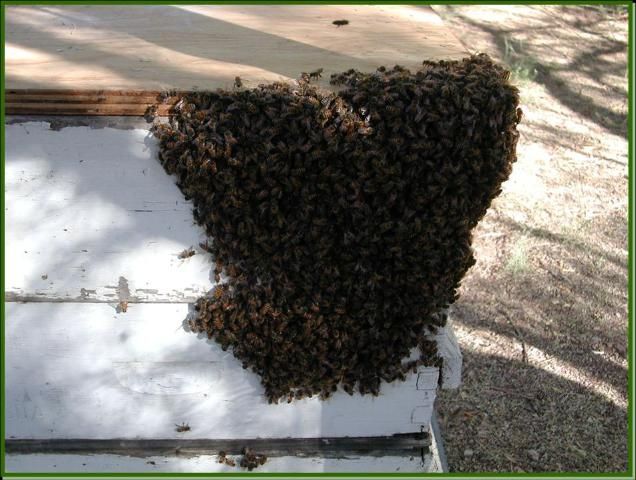
Credit: University of Florida Honey Bee Research and Extension Lab
What's in a name?
In popular literature, "African," "Africanized," and "killer" bees are terms that have been used to describe the same honey bee. However, "African bee" or "African honey bee" most correctly refers to Apis mellifera scutellata when it is found outside of its native range. A. m. scutellata is a subspecies or race of honey bee native to sub-Saharan Africa, where it is referred to as "Savannah honey bee" given that there are many subspecies of African honey bee, making the term "African honey bee" too ambiguous there. The term "Africanized honey bee" refers to hybrids between A. m. scutella and one or more of the European subspecies of honey bees kept in the Americas. There is remarkably little introgression of European genes into the introduced A. m. scutellata population throughout South America, Central America, and Mexico. Thus, it is more precise to refer to the population of African honey bees present in the Americas as "African-derived honey bees." However, for the sake of simplicity/consistency, we will refer to African-derived honey bees outside of their native range as "African honey bees" or "AHBs".
Swarm Prevention Techniques
Swarm prevention should be initiated before the first significant nectar flow begins. Recognizing the signs of the approaching swarm season is crucial to preventing a swarm from happening. There are numerous practices a beekeeper can employ to limit or prevent swarming. Diligent monitoring of the hive during early spring through the nectar flow is the most important part of each of the following described practices.
Providing adequate brood space and preventing overcrowding are simple and moderately effective swarm preventive measures. For those beekeepers who use two or more supers as brood chambers: the colony cluster typically moves from the bottom super into upper supers in late winter. This often leaves ample space below the bee cluster as spring approaches, but the bee cluster often is reluctant to migrate downward in the hive because of natural bee behavior. This can cause crowding and congestion in the upper supers of the colony. The solution to this dilemma is simply to reverse the super positions so that the upper super containing the congested bees is now the bottom super. The bees will move up into the "new," mostly empty super on top and congestion will be relieved. For beekeepers who use only one super as a brood chamber: colony congestion can be relieved by adding empty supers to the colony. Bees prefer empty space above them.
Colony equalization is also an important component of swarm management. As colonies come out of winter and begin to show signs of crowding, brood and food frames can be removed from strong colonies and placed into colonies that weakened over the winter. The removed brood and food frames taken from the strong colony can be replaced with drawn combs to provide "empty combs" in which the queen can lay. Moving brood/food combs to weaker colonies helps strengthen the colony before the primary nectar flow. Colony congestion can be relieved further by creating splits (or nucs, short for "nucleus colonies") from strong colonies. A nuc is essentially a controlled swarm, and it is the technique most often used by commercial beekeepers to control swarming. The idea is simple: 2–4 frames of bees and brood can be removed from strong colonies and used to create new colonies. This relieves congestion, replaces an aging queen (if she is moved into the split), and helps to alleviate swarming tendencies. For detailed information on splitting colonies and making nucs, see https://edis.ifas.ufl.edu/in869.
Requeening a colony can help minimize swarming tendencies. Young queens produce more pheromones, thus inhibiting swarm preparation by the workers. It is best to enter the main nectar flow with a young, strong queen who will be laying at an optimal rate. This will ensure a robust population of bees for the production of honey or other managed hive products. Though requeening a colony 4–6 weeks before the principal nectar flow is advisable, it usually is difficult to acquire queens in early spring. A good alternative is to requeen colonies in late summer when queens often are more available. It is important to requeen colonies with European queens purchased from a reputable source to minimize the potential introduction of African bees into your apiary.
Clipping a queen's wing is a good way to minimize swarming tendencies in colonies (Figure 7). Since it usually is the old queen who leaves the colony with the swarm, clipping a queen's wing keeps her from being able to leave with the swarm. To clip a queen's wing, hold the queen between the thumb and pointer finger as seen in Figure 8. Take a small pair of scissors and cut off ½ of the forewing (the large, front wing) on one side of the queen's body (Figures 8 and 9). A clipped queen will try to leave the colony with a swarm, but she will not be able to fly away with it, and the swarm will return to the nest. Frustrated swarms (those that cannot "coerce" their queen to swarm because she is clipped) often kill their queen in an attempt to rear one that can fly. So, clipping a queen's wing is more of a safety net than a method of reducing the swarming tendency. This technique is most effective in controlling swarms when other swarm control methods are practiced at the same time. Worth noting is that a clipped queen sometimes will be unable to reenter the colony after a failed swarm attempt. In this instance, she will climb up a nearby bush or under the colony where the swarming bees will cluster around her. These swarms are easy to capture and can then be housed in a new hive. One should not try to reintroduce the swarm back into the parent colony. Once a colony tries to swarm, it will continue to do so.
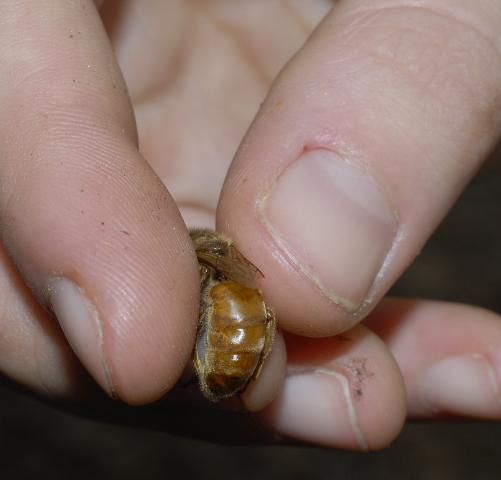
Credit: Catherine Zettel Nalen, University of Florida
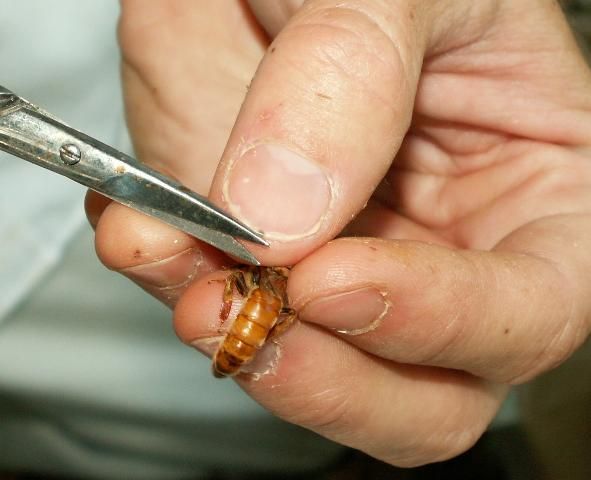
Credit: Amanda Ellis
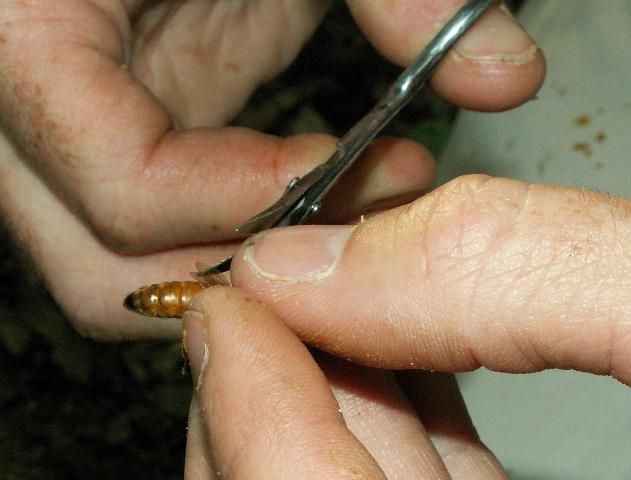
Credit: Amanda Ellis
Removing queen cells from colonies before they swarm, a technique called "cutting queen cells," is useful as a swarm behavior repressor. Cutting queen cells involves inspecting colonies weekly, immediately before and during swarm season, in an effort to remove queen cups and queen cells from the colony. This is a time-consuming endeavor and most practiced by hobbyist and sideliner beekeepers. This technique works best when the hive is inspected every seven to nine days. When done, every frame in the colony containing brood should be removed from its respective super and the bees shaken from the frame (over the hive body) with 1–3 quick shaking motions. It is important to shake as many bees from the frame as possible because bees can easily hide swarm cells on a frame. If one queen cell is missed and allowed to be capped, the hive will be prompted to swarm. It only takes about seven to ten days for new capped queen cells to develop, so it is important to repeat this process weekly.
Honey bees nesting on your property?
The state of Florida recommends that nuisance honey bees (https://edis.ifas.ufl.edu/in1005 and https://edis.ifas.ufl.edu/in790) found nesting outside of hives managed by a beekeeper (like those nesting in tree cavities, walls, water meter boxes, etc.) be either (1) removed from the nest site by a registered beekeeper (https://www.fdacs.gov/Agriculture-Industry/Bees-Apiary/Beekeeper-Registration) or trained Pest Control Operator (PCO) or (2) eradicated by a PCO. Consult the publication "Choosing the Right Pest Control Operator for Honey Bee Removal: A Consumer Guide" (https://edis.ifas.ufl.edu/in771) for advice on hiring a PCO. It is the responsibility of the property owner to deal with an unwanted swarm (https://edis.ifas.ufl.edu/in970) or colony of honey bees. To find a registered beekeeper or PCO who offers removal or eradication services, visit: https://www.fdacs.gov/Consumer-Resources/Consumer-Rights-and-Responsibilities/Pest-Control/Honey-Bee-Removal-or-Eradication-in-Florida. For more information on African honey bees, see https://www.fdacs.gov/Consumer-Resources/Health-and-Safety/Africanized-Honey-Bees or https://edis.ifas.ufl.edu/entity/topic/africanized_honey_bee. (Modified from FDACS: https://www.fdacs.gov/content/download/71121/file/bee-removal-or-eradication-list.xlsx).
Conclusion
Proper spring management practices can help to prevent swarms. It is important to be able to recognize the signs of swarm preparation in the colony. Once queen cells are capped, it is nearly impossible to stop the bees from trying to swarm. Swarm prevention should already be underway about four weeks before the anticipated primary nectar flow begins. Use combinations of the following swarm control measures to limit swarming behavior by colonies.
- Clip ½ of one forewing of the queen.
- Remove frames of bees/brood to add to weaker colonies or use to create nucs.
- Requeen colonies yearly.
- Cut queen cells from colonies every seven to nine days beginning four weeks prior to the primary nectar flow and throughout.
- Provide adequate empty combs in the brood nest and/or add supers to colonies to reduce colony congestion.
- Equalize strong and weak colonies prior to the primary nectar flow.
References
Caron DM. 2006. Honey Bee Biology and Beekeeping. Cheshire, CT: Wicwas Press, LLC.
Delaplane KS. 2006. Honey Bees and Beekeeping: A Year in the Life of an Apiary. The University of Georgia and Keith S. Delaplane, USA. 108 pp.
Ellis JD, Ellis A. 2009. African Honey Bee, Africanized Honey Bee, Killer Bee, Apis mellifera scutellata Lepeletier (Insecta: Hymenoptera: Apidae). EENY 429. https://edis.ifas.ufl.edu/in790 (July 2019)
Ellis JD, Zettel Nalen CM. 2010. Using Nucs in Beekeeping Operations. ENY153. https://edis.ifas.ufl.edu/in869
MAAREC (Mid-Atlantic Apicultural Research & Extension Consortium). 2000. Swarming–Control.
MAAREC Publication 3.4. https://canr.udel.edu/maarec/wp-content/uploads/sites/18/2010/03/Swarm_Prev_Control_PM.pdf (May 2022).